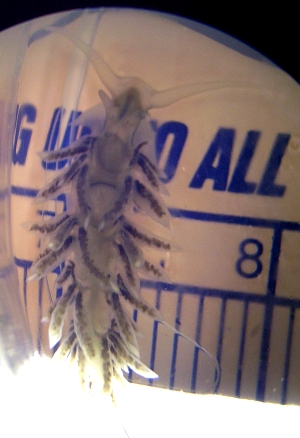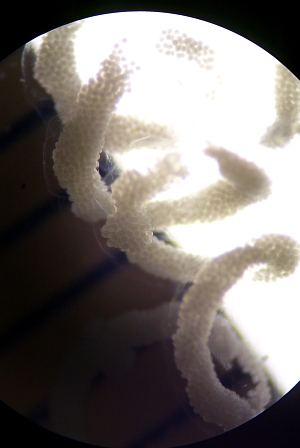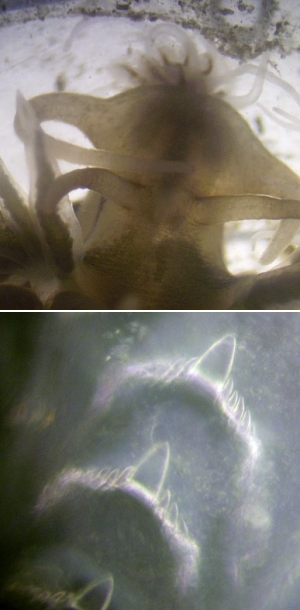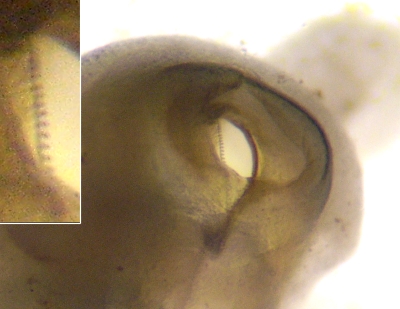Cratena pilata from North Carolina, USA
December 4, 2006
From: Tony Fernando

Concerning message #1130:
Hello Dr. Rudman,
We recently have collected upwards of 20 specimens of Cratena pilata. The initial specimens were collected from the side of an upweller receiving raw-seawater. We have also collected this species when we raised out of the water for cleaning a strainer that feeds our flow through system. Dr. Miller at the University of Auckland very patiently helped us with the identification.
Locality: Morehead City, 0-6m, North Carolina, USA, Bogue Sound, 1-29 November 2006. Length: 8-24mm. Photographer: Tony Fernando and Janet Hanson.
I am providing this from my notes since the forum page for this species is a little sparse. The species has been collected here in several locations before. (Wilson, 1979)
General: Specimens ranged from 8 mm to 24 mm long. The body is generally translucent, though some specimens had reddish or brown spots of pigment, especially between the rhinopores. The rhinopores are "rough" (I don't know the correct term, they are not simple, and do not have rings or branching) Some specimens had a band of brown pigments midway on the rhinopore. Oral tentacles are longer than the rhinopores, on undamaged specimens they could be up to 2x longer than than the rhinopores.
Cerata were generally clear (1 specimen had the gold flecking seen in the pictures in message #1130 ). Cerata contain a green branching digestive gland and a white-to-clear terminal sac. Cerata are arranged in arches along the side of the body. Larger specimens had 6 arches, smaller ones 5. The largest cerrata in each arch are at the apex of the arch, small and budding cerrata are at the two endpoints. The genital aperture is located forward of the leading tip of the first arch on the right side. The anus is located in the center of the second arch, also on the right side.
Eggs and Larvae: Eggs are laid in a ribbon of capsules, with one egg per capsule. Ribbons were laid on glass, plastic, hydroids, and bryzoans. When laid on glass, the eggs were generally deposited in a spiral, though ragged lines were also observed. Eggs hatch in 4 days when maintained in standing seawater at room temperature. Size at hatching is 100 micron measured accross the shell. Hatched larvae feed readilly on Isochrysis galbana, by creating a current with their cillia that draws the algae to their mouth. We have not sucessfully cultured the larvae to metamorphosis.
When isolated, C. pilata over 12 mm generally laid eggs within 48 hrs of isolation. Specimens under 12 mm never did.
Adult feeding: Adult specimens were observed feeding on hydroids. Fecal analysis showed several local diatoms intermixed in the fecal matter. I don't know if that means the animal is eating the biofilm off the hydroid or the hydroid itself and ingesting the diatoms in the process.
-
Wilson, W. H.. (1979) An Annotated Checklist of the Shallow-water Marine Invertebrates of the Morehead city-Beaufort Region of North Carolina. (C.H. Preston, Ed.). Morehead City: University of North Carolina Institute of Marine Sciences
Sincerely,
Tony Fernando
Student
Department of Applied Marine Science
Carteret Community College
Morehead City, NC, USA
anthonyfernando@yahoo.com



Dear Tony,
Thanks for this detailed information. You are right in thinking the Fact Sheet for this species is a bit sparse. It is surprising how little readily available information is available on the opisthobranch fauna of the temperate region of the Nth American east coast. The only general source I know is Sherman Bleakney's book for Canada and the Gulf of Maine. This species is a good example, well illustrating Terry Gosliner's comment [#1142] that 'many of the common species in New England are in need of taxonomic revision'.
I like the photo of the mouth showing the serrated edge of one of the jaw plates.
-
Bleakney, J.S. (1996) Sea Slugs of Atlantic Canada and the Gulf of Maine
Best wishes,
Bill Rudman
Related messages
-
Re: Aeolid from New York
From: Anthony Fernando, December 15, 2006 -
Aeolid from New York
From: Betsey Hansen, July 31, 1999 -
Re: Aeolid from New York
From: Terry Gosliner, July 31, 1999
